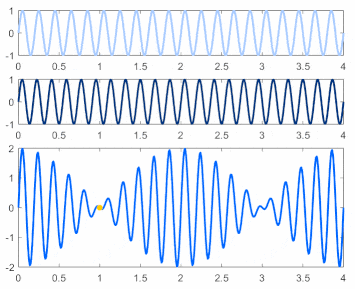Timoshenko-Ehrenfest beams
Stephen Timoshenko, together with Paul Ehrenfest, later added the shear deformation making use of a shear coefficient that will be discussed in a section below.
Note that it is not clear (at least to the author) if Timoshenko & Ehrenfest developed their model based on the work by Rayleigh (which they were aware of) or from the work by Jacques Antoine Charles Bresse (who developped, years before Rayleigh, a beam model accounting for both rotary inertia and shear deformation but without any correction that will lead to the introduction of the shear coefficient).
When compared with Euler-Bernoulli or Rayleigh beam models, Timoshenko-Ehrenfest model allows to predict the larger deflections under static loads of "thick" beams or the lower eigen-frequencies of beams under dynamic behaviors.

The analysis of the free vibrations for such a beam, leads to a coupled system of equations :
\[
\begin{aligned}
G\kappa A \left( \frac{\partial^2 w}{\partial x^2} + \frac{\partial \phi}{\partial x} \right) - \rho A \frac{\partial^2 w}{\partial t^2} &= 0 \\
EI\frac{\partial^2\phi}{\partial x^2} - G\kappa A \left( \frac{\partial w}{\partial x} + \phi \right) - \rho I \frac{\partial^2 \phi}{\partial t^2} &= 0 \\
\end{aligned}
\]
The elimination of the cross-sectional rotation $\phi$ leads to the fourth-order differential equation (both in space and in time) :
\[
EI \frac{\partial^4 w}{\partial x^4} - \rho I \left(1 + \frac{E}{G\kappa} \right)\frac{\partial^4 w}{\partial x^2\partial t^2} + \rho A \frac{\partial^2 w}{\partial x^2} + \frac{\rho^2 I}{G\kappa} \frac{\partial^4 w}{\partial t^4} = 0
\]
Some authors prefer to eliminate the transverse displacement $w$ instead of $\phi$ and they end up with the same equation, $w$ being replaced with $\phi$ i.e. both variables have the same time and space dependence).
The corresponding characteristic equation is a bi-quadratic equation :
\[
k^4 - k^2 \omega^2 \frac{\rho}{E} \left( 1 + \frac{E}{G\kappa } \right) - \omega^2 \frac{\rho A}{EI} + \omega^4 \frac{\rho^2}{G\kappa E} = 0
\]
4 solutions are possible for the wavenumber and the behavior of the beam depends on a "cutoff" pulsation $\omega_c$ defined as the square root of the ratio between the shear stiffness and the rotary inertia :
\[
\omega_c^2 = \frac{\kappa G A}{\rho I}
\]
(all quantities being positive, there's only one physical solution for $\omega_c$ which is $+\sqrt{\omega_c^2}$).
For $\omega < \omega_c$, 2 wavenumbers describe propagative waves (in opposite direction) and the remaining 2 describe evanescent waves (in opposite direction).
For $\omega > \omega_c$, the 4 wavenumbers describe propagating waves and there is thus 2 different waves propagating at each pulsation above $\omega_c$. The first wave is the flexural one. The second one belongs to what have been called the
second spectrum (which can be disregarded under some conditions like long beams and specific boundary conditions).
